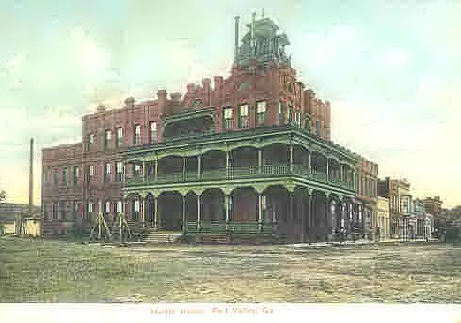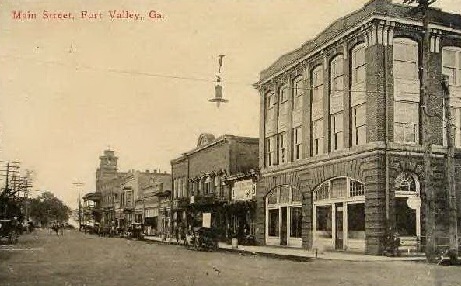
The grand old Harris House (circa 1910), later remodeled and renamed Winona Hotel

Main Street looking east (circa 1910)

Fort Valley Main Street looking west (circa 1910)
Fort Valley was founded in the 1820s as a Native American trading post at the intersection of two early Indian trails. That crossing of trails made it a natural place for North Carolinian James Abbington Everett to set up a trading post. Everett was joined by Mathew Dorsey, Peter Greene and William and Allen Wiggins in settling the new community.
The origin of the town's name is unclear. One story claims that Everett named it "Fox Valley" but that his writing was misread by post office officials in Washington, D.C., as "Fort Valley." Another story claims that Everett named the town after his friend Arthur Fort, a Revolutionary War (1755-1838) hero from nearby Milledgeville. In any case, it seems that there was never a military fort on the site.
According to United States Post office for the period 1789-1930 now kept in the National Archives, a post office was established in Fort Valley, Crawford County, Ga., on Dec. 7, 1825, with Everett as postmaster. No other name for this office was found in the archives.
In a letter to the late Thelma Wilson, W.H. Harris wrote many years ago, "The post office of Fort Valley was originally in Crawford County. The county lines didn't move as they later did from Houston to Peach County, but Fort Valley moved. It was originally about two miles out on the Atlanta Highway."
James Everett became a wealthy and influential plantation owner, donating funds for the education of Georgians and using his influence to ensure that the railroad came through his new town, although he died before the first train pulled into the station in Fort Valley. Splitting the city in half north and south, the railroad has played a prominent and important role in the growth of Fort Valley. A large brick freight depot was built on the west side of what is now Main St. in 1871 and a passenger terminal was added in 1900.
At one point, passenger and freight traffic through Fort Valley was so heavy two large hotels, the Winona at Main St. and the Bassett (also known as the Watson House and the Central Hotel) at Hwy. 96, were built to house the many visitors to the city. The Winona was torn down in the mid-1960s and the Bassett was destroyed by fire in 2006.
For many years the primary method of shipping peaches to northern markets was by rail, so trains crowded the multiple tracks in downtown Fort Valley 24 hours a day during the hectic summer days of Peach season.
An interesting picture of pioneer days around Fort Valley was preserved in "Reminiscenses of Fort Valley," by Mrs. Osborn Rogers Flournoy.
She wrote, "The early settlers of Fort Valley, men and women of piety, culture and wealth, were attracted from other states by the farming lands. Although the first houses were built of logs, they were afterwards replaced by timbered dwellings in colonial style. These homes had no clothes closets, waterworks nor artificial lights, but they did have spacious rooms with lofty ceilings and huge fireplace.
"Each house had its flower garden, English style, laid out in beds with walks edged in boxwood, the whole surrounded by white picket fence and a close-trimmed hedge. Outside of these grounds were the usual groves of oaks, under which were the plantation out-buildings. All kinds of fruit, vegetables, cattle and poultry were raised to support the family."
City Chartered in 1856
Fort Valley was chartered by a legislative act approved on March 3, 1856, with C.D. Anderson, William H. Hollinshead, William I. Greene, A.D. Kendrick and D.N. Austin appointed as commissioners. They were empowered by the legislature to "make laws and regulations for a government in the best interest of the citizens" and were appointed to serve until their successors were elected. Dr. William Mathews, state representative for Houston County in which Fort Valley was then located, introduced the bill for incorporation.
No record of the first elected officials has been found and the first known elected mayor was A.C. Riley who was voted into office on April 9, 1888. He resigned from office on Jan. 7, 1890, and J.L. Fincher served until the next election in April of that year.
The original charter established the town limits as one mile in each direction from the railroad depot. Outside the one-mile radius large plantations grew up, devoted at first to cotton and later to peaches, asparagus and pecans. The development of the Elberta peach and excellent rail connections taking the fresh fruit great distances combined to make Fort Valley the peach-growing center of Georgia.
The first school, Fort Valley Academy, was charted on Dec. 24, 1836, with Everett as one of its trustees. Organized in 1840 as the Old Pond Church, the current Fort Valley United Methodist Church was the first church in Fort Valley. The First Baptist Church was organized in 1852 and Ushers Temple C.M.E. Church, the first free African-American church, was established in 1866. The first newspaper, The 19th Century, was published in the 1850s.
Peach Festivals Add to Colorful History
Toward the final stages of efforts to bring about the creation of a new county, the idea of the Peach Blossom Festival was conceived. Between 1922-26, Fort Valley greeted the first peach blossoms in annual festivals of dance, song, elaborate pageants and delicious barbecue. Soon thousands from all over the world would make their way to Fort Valley each March. It has been reported that as many as 40,000 people descended on the town during the festival, which was ended in 1926 because it was too successful.
Sixty years later, in 1986, Fort Valley staged the first Georgia Peach Festival. This revived festival, now in its 20th year, resulted from a suggestion by Harold Peavy to promote Peach County and the peach industry that has contributed so much to the livelihood of the middle Georgia area.
The festival officially incorporated in 1988 under the direction of the Peach County Chamber of Commerce. Today, a volunteer board of directors plans and executes the complex job of organizing the festival in Fort Valley and Byron. With many residents joining the effort to make the festival bigger and better each year, attendance from outside the area is growing yearly.
Tornado Changes Face of City in 1975
While Fort Valley has survived its share of fires and other catastrophes, one of the worst had to be the 1975 tornado. The Category 3 storm with maximum winds in the 158-206 mph range entered the city from the west and left a path of destruction through the heart of Main St., ripping the fronts off nearly every building on both sides of the street. Two people were killed by the storm, 50 were injured and damages were estimated at between $5 million and $50 million.
Beginning with the recovery from that devastating storm, Fort Valley has worked diligently to improve its downtown business district and to position itself to grow in the new century.
As with many other American agricultural communities, Fort Valley has been through a period of economic retrenchment. As the economy has moved away from heavy dependence on agriculture, Fort Valley residents have found employment at Blue Bird as well several newer industries. Fort Valley State University is one of the city's largest employers and other residents are finding work in a budding tourist economy.
Through the diligent efforts of Fort Valley's Mainstreet program, the city was chosen as one of the Georgia Municipal Association's Cities of Excellence for 2003.
This history assembled by Jimmy Bennett with assistance from the Thomas Public Library. Information was taken from the New Georgia Encylopedia, a History of Peach County, Georgia, compiled by the Gov, Truetlen Chapter of the Daughters of the American Revolution and published by the Cherokee Publishing Co. in 1972. Additional information was found on the websites of the Georgia Peach Festival, Main Street Fort Valley, the Peach County Historical Society and Historical Phields on kommish.net.